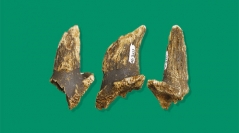

 Comptes Rendus Palevol
21 (21) - Pages 431-450
Comptes Rendus Palevol
21 (21) - Pages 431-450The Cooper’s D deposit has been dated by U-Pb at a maximum age of 1.37 Ma ± 0.113 and has yielded seven Hominini remains, six of them are attributed to the Southern African endemic species Paranthropus robustus Broom, 1938. However, the taxonomic composition of the faunal assemblage recovered at this site, especially ruminants, remains poorly understood. This paper updates the previous palaeontological and biochronological works and provides the first taxonomic description and paleoecological analysis of the whole bovid material from Cooper’s D. We propose a minimum age of 1.0 Ma for the Cooper’s D bone accumulation. Thus, we conclude that the assemblage accumulated between 1.375 ± 0.113 and 1.0 Ma based on the complementary results obtained from radiometric dates and biochronology. The paleoecological analysis suggests that Cooper’s D is likewise dominated by grassland with sparse covered habitat and probable water sources in the vicinity. Finally, we show a strong statistically significant negative correlation between the presence of grassland-adapted bovid species and P. robustus. This result indicates that P. robustus was more likely to be an eurytopic species and dietary generalist than an exclusive grazer.
Bovid, paleoecology, Cooper’s Cave, Early Pleistocene, South Africa